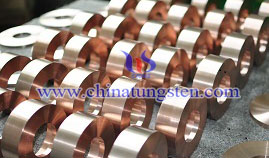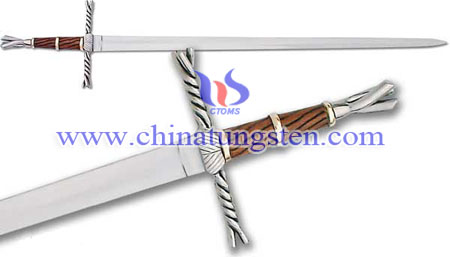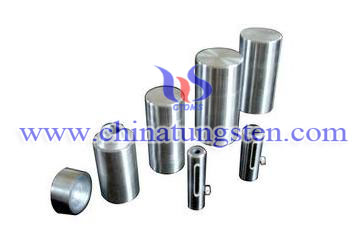Tungsten Alloy Counterweights Liquid-phase Sintering Preparation MethodⅡ
- Details
- Category: Tungsten Information
- Published on Tuesday, 22 December 2015 16:55
- Written by yaqing
- Hits: 273
| Tungsten Alloy Supplier: Chinatungsten Online www.tungsten-alloy.com | Tel.: 86 592 5129696; Fax: 86 592 5129797;Email:sales@chinatungsten.com |
| Tungsten News & Prices, 3G Version: http://3g.chinatungsten.com | Molybdenum News & Molybdenum Price: http://news.molybdenum.com.cn |
Tungsten Copper Electrode Metallographic Phase and Properties Analysis
- Details
- Category: Tungsten Information
- Published on Tuesday, 22 December 2015 16:53
- Written by xiaobin
- Hits: 251
Tungsten copper powder sintered material morphology distribution of tungsten skeleton evenly distributed on the copper matrix. Due to the nature of tungsten (W) high melting point and high hardness, tungsten at 1000 ℃, its ultimate tensile strength is still 50kgf/mm2, low carbon intensity is even higher than room temperature, which makes tungsten copper material copper melting point below the temperature (about 1000 ℃), still has a very high wear resistance and heat hardness. The tungsten skeleton with copper as matrix stick as a whole, and constitutes the sintered material good heat conductor and pathways, so that the tungsten skeleton used in the process does not has partial overheating.
The strength at room temperature of common metal is determined by two essentials, which are Metal atomic binding force and resistance to dislocation motion. When tungsten copper used as electrode in welding resistance, it improves the strength by enhancing the resistance to dislocation motion, which includes cold hardening and the demolition. However, with the increasing temperature, the effect will remarkably decrease, even disappear. For instance, after cold hardening, the hardness at room temperature of red copper is HB100-110, when the temperature reaches 200-250℃, the hardening effect will disappear almost. In addition, most of strengthening copper alloy by precipitate phase will weaken owing to the phase integrates into the matrix again.
In contrast, the recrystallization and phase change of copper-tungsten powder sintered material does not occur at a high temperature. Some studies show that the data on tungsten copper materials, tungsten, copper W-30Cu hardness and conductivity higher than beryllium copper, the softening temperature was more than twice as beryllium copper. Therefore, tungsten copper material used as flash butt welding or arc welding electrodes, especially in continuous operation at high temperatures, which has high requirements of conductivity and high wear resistance requirements, it will better highlight the tungsten copper electrode material superiority.

| Tungsten Copper Supplier: Chinatungsten Online tungsten-copper.com | Tel.: 86 592 5129696; Fax: 86 592 5129797;Email:sales@chinatungsten.com |
| Tungsten News & Prices, 3G Version: http://3g.chinatungsten.com | Molybdenum News & Molybdenum Price: http://news.molybdenum.com.cn |
Tungsten Alloy Sword Hilt Counterweights
- Details
- Category: Tungsten Information
- Published on Tuesday, 22 December 2015 16:46
- Written by yaqing
- Hits: 452

| Tungsten Alloy Supplier: Chinatungsten Online www.tungsten-alloy.com | Tel.: 86 592 5129696; Fax: 86 592 5129797;Email:sales@chinatungsten.com |
| Tungsten News & Prices, 3G Version: http://3g.chinatungsten.com | Molybdenum News & Molybdenum Price: http://news.molybdenum.com.cn |
Tungsten Alloy Counterweights Liquid-phase Sintering Preparation MethodⅠ
- Details
- Category: Tungsten Information
- Published on Tuesday, 22 December 2015 16:51
- Written by yaqing
- Hits: 322

| Tungsten Alloy Supplier: Chinatungsten Online www.tungsten-alloy.com | Tel.: 86 592 5129696; Fax: 86 592 5129797;Email:sales@chinatungsten.com |
| Tungsten News & Prices, 3G Version: http://3g.chinatungsten.com | Molybdenum News & Molybdenum Price: http://news.molybdenum.com.cn |
Effects of Ammonium Paratungstate Calcination Temperature on Properties of Tungsten Powder
- Details
- Category: Tungsten Information
- Published on Tuesday, 22 December 2015 14:32
- Written by xinyi
- Hits: 285
| Tungsten Supplier: Chinatungsten Online www.chinatungsten.com | Tel.: 86 592 5129696; Fax: 86 592 5129797;Email:sales@chinatungsten.com |
| Tungsten News & Prices, 3G Version: http://3g.chinatungsten.com | Molybdenum News & Molybdenum Price: http://news.molybdenum.com.cn |





 sales@chinatungsten.com
sales@chinatungsten.com